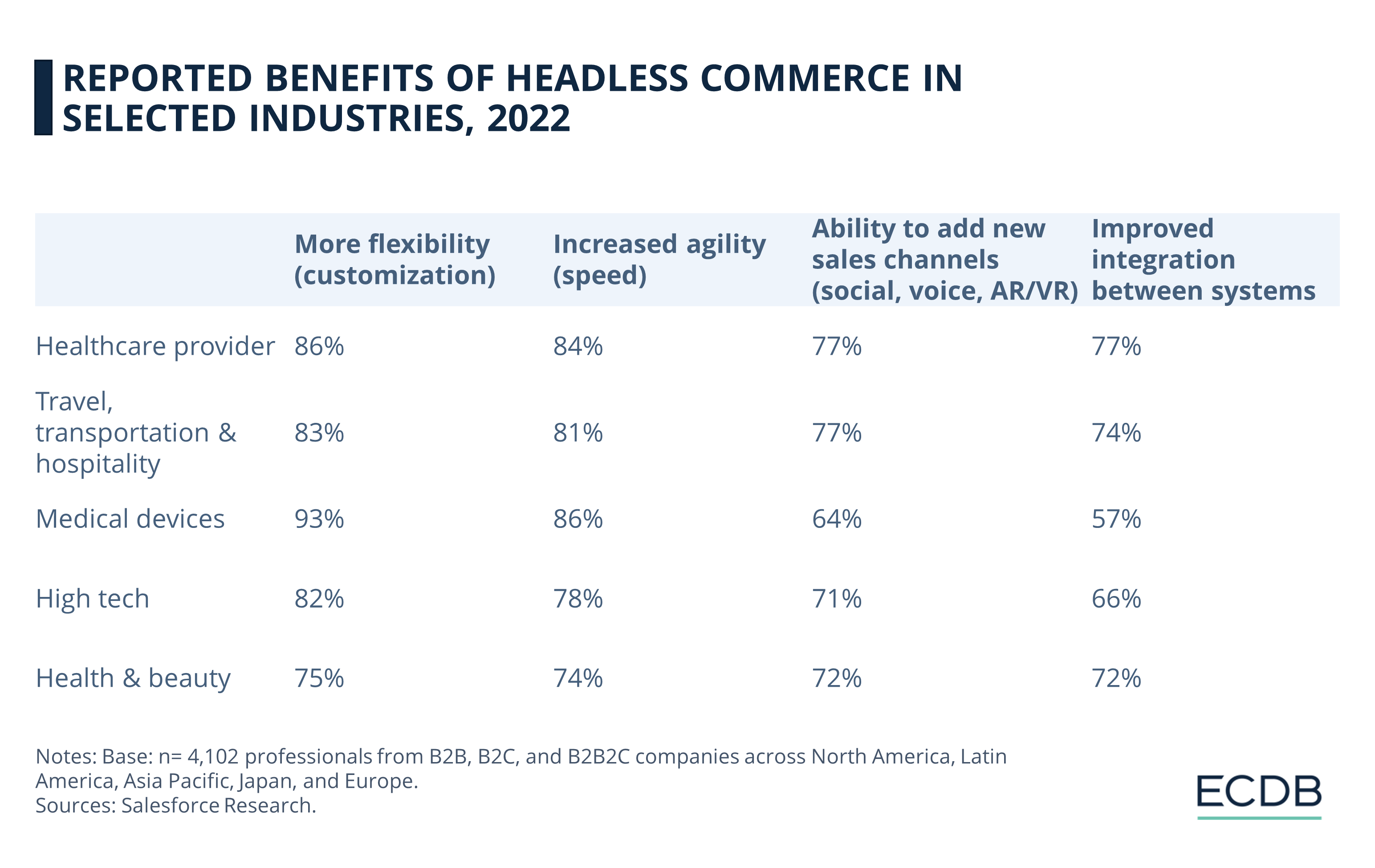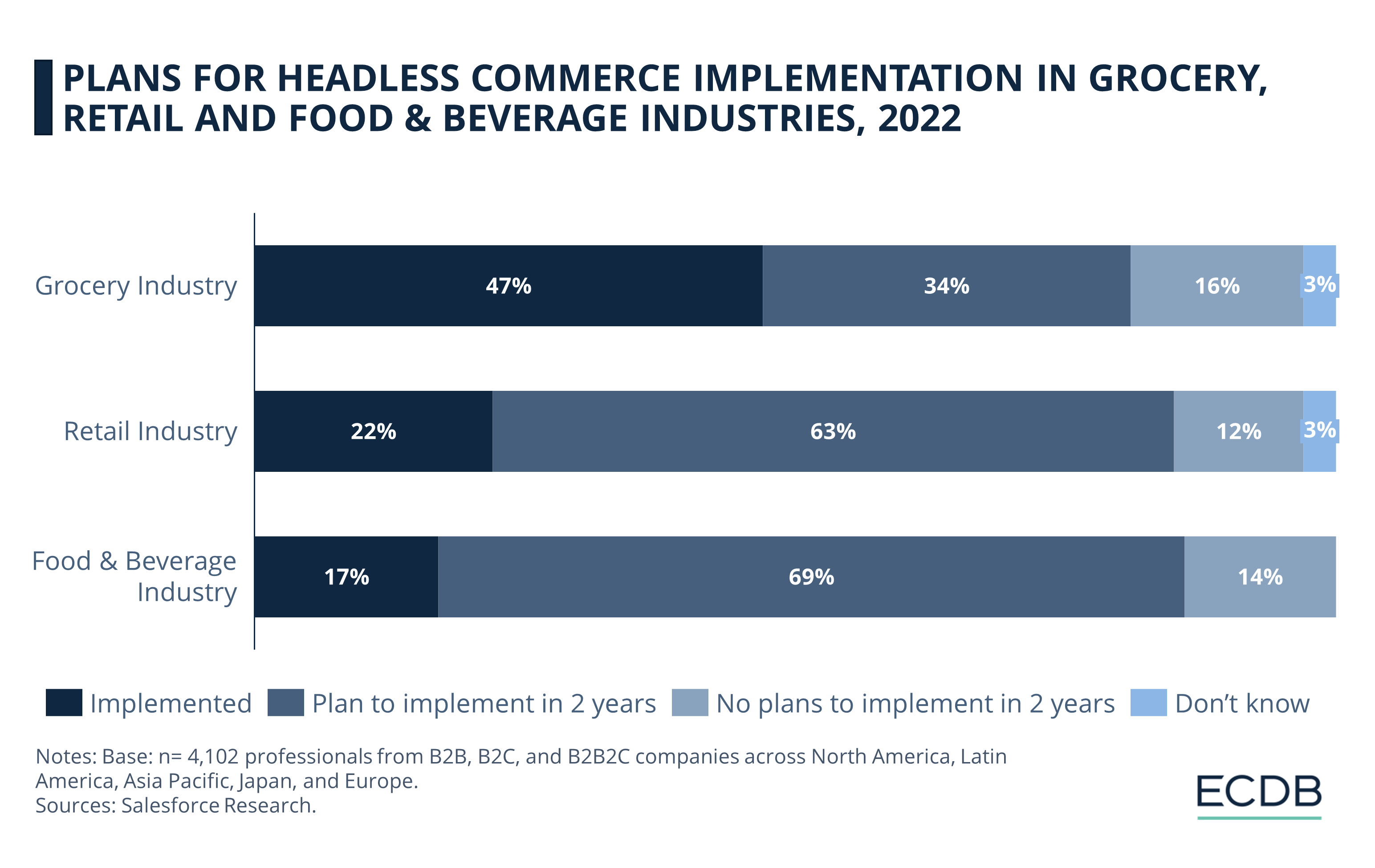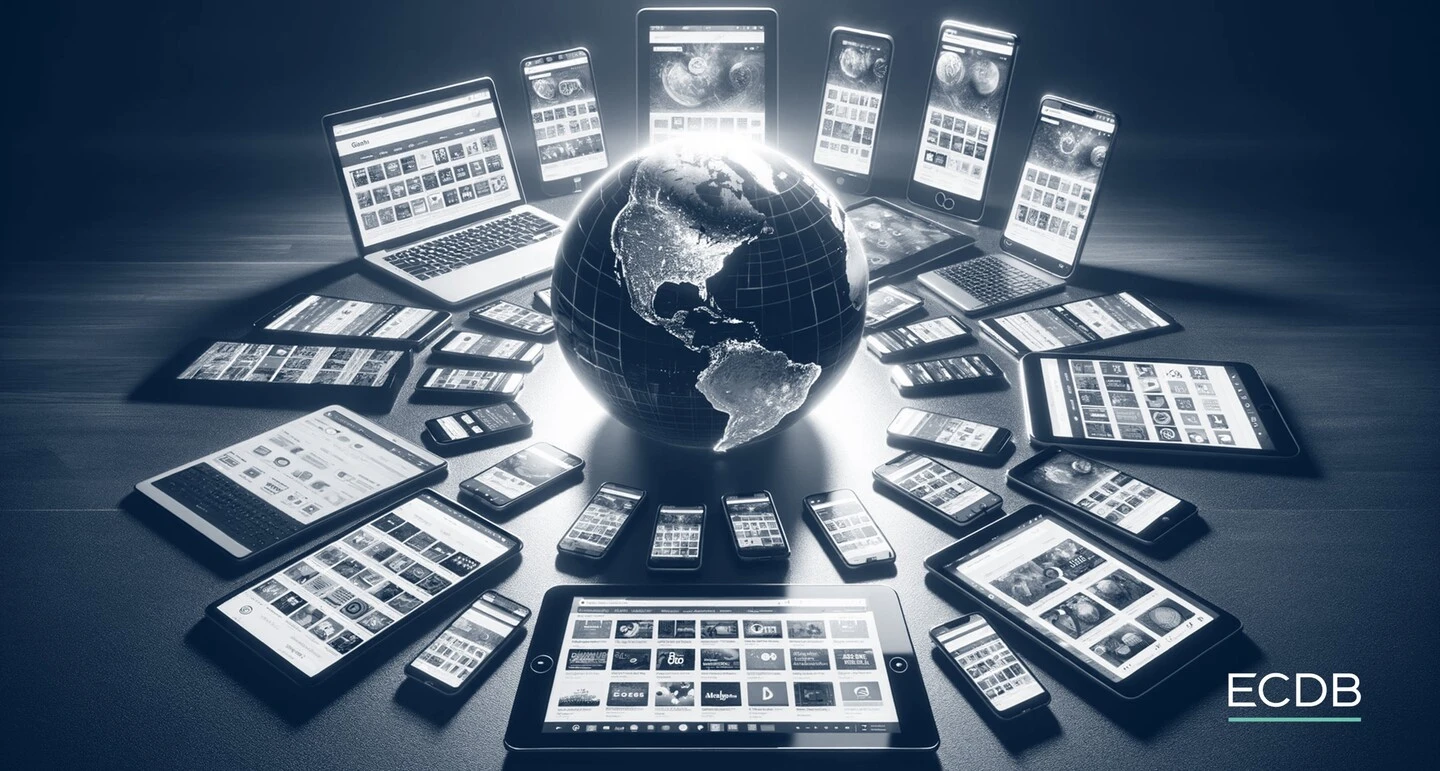eCommerce: Headless Commerce
Headless Commerce: What Is It & Why Should You Use It?
Headless technologies separate the frontend from the backend, enabling faster, more flexible responses to market demands. How does this transform eCommerce?
Article by Cihan Uzunoglu | May 21, 2024Download
Coming soon
Share

Headless Commerce: Key Insights
System Integration and Flexibility: Headless commerce enhances system integration, flexibility, speed, and sales by separating the frontend from the backend, allowing for seamless updates and the incorporation of new technologies across all customer touchpoints.
Survey Insights: A survey by Salesforce in February 2022 found that the top benefits of headless commerce across various industries are greater flexibility, the ability to expedite changes, and improved integration, with the pharmaceutical, medical devices, and healthcare sectors particularly highlighting these advantages.
Industry Adoption Rates: Adoption of headless commerce varies, with 47% of the grocery sector already using it, 63% of the retail sector planning to adopt it within two years, and nearly 70% of the food and beverage sector intending to implement it soon.
Ever lost your head over a big online deal?? We all have, but that’s not what "headless commerce" refers to. So what does it actually mean?
What is Headless Commerce?
Headless commerce, an increasingly prevalent term in today's digital ecosystem, refers to a commerce solution where the frontend or the presentation layer (the "head") is decoupled from the backend or the business logic and functionality layer.
This separation empowers businesses to deliver rich customer experiences across various touchpoints, unhindered by the limitations of traditional eCommerce systems. Salesforce Commerce Cloud, Shopify and Magento are among the popular headless commerce providers.
1. More Integration Between Systems
Headless commerce significantly improves integration between systems. Traditional commerce platforms often come with integration constraints, making it challenging to unify the customer experience across different systems.
In a headless commerce system, an online retailer's front-end (website or app) is directly linked to its back-end systems - like CRM (Customer Relationship Management) for customer data, ERP (Enterprise Resource Planning) for inventory, and CMS (Content Management System) for website content - via APIs (Application Programming Interface). This ensures real-time data exchange and updates.
For instance, when a product goes out of stock, the CMS can instantly update the website to reflect this change because of the immediate updates from the ERP.
Additionally, when introducing new customer touchpoints like a mobile app, the retailer can simply develop the front-end and connect it to the existing back-end through APIs. This maintains consistent data and user experiences across all platforms, improving customer experience. Therefore, headless commerce ensures a seamless, unified customer journey across various systems and touchpoints.
2. More Flexibility For Developers
Headless commerce also allows developers to create custom user interfaces using the technology stack they prefer, whether for web, mobile, or any other customer touchpoint. Because the frontend is separated from the backend, businesses can change, modify, and innovate the customer-facing side without disrupting the operational logic running in the background.

3. Faster Software
Another notable advantage is increased agility. A headless architecture enables quicker modifications, updates, or feature additions to the commerce platform. It can allow businesses to respond to market changes swiftly, experimenting with different frontend experiences until they find the optimal fit for their consumers.
4. Headless Commerce: Increased Sales
The ability to add new sales channels is another compelling reason to go headless. Businesses are not restricted to predefined templates or platforms. They can seamlessly integrate emerging technologies such as augmented reality (AR), virtual reality (VR), or IoT (Internet of Things) devices, opening new avenues for customer engagement and sales.
Headless Commerce: Benefits for
Different Industries
Going deeper, gravity of these benefits varies across different sectors.

A survey conducted by Salesforce in February 2022 shows how headless commerce can benefit different markets in different ways:
The topmost perceived advantage of headless commerce was identified as greater flexibility - the capacity to personalize digital experiences. Following closely behind was the heightened capability to expedite changes.
More flexibility, to be able to customize digital experiences, turned out to be the most commonly reported benefit for each industry mentioned here. Among these selected sectors, the medical devices industry reported the highest percentages for the benefits of “more flexibility” and “increased agility”.
In comparison to other sectors included in the chart, healthcare providers reported the highest percentages for the reasons “ability to add new sales channels” (in a tie with travel, transportation and hospitality) and "improved integration between systems”.
How Well Are Different Industries Implementing Headless Commerce?
Looking at some of the industries that are arguably the most central in eCommerce, namely – grocery, retail, and food & beverage, we observe different attitudes towards headless commerce and its applications. Some have already recognized these benefits and implemented headless commerce exercises, while others have not but are planning to in the future.

In the grocery sector, as of February 2022, almost half (47%) of survey participants indicated that they have already incorporated headless architecture into their business operations. An additional 34% intend to employ headless commerce within the upcoming two years, while 16% do not foresee its implementation anytime soon.
As for the retail sector, plans to incorporate headless commerce within the next two years have been declared by 63% of the respondents, whereas 12% have no intention of doing so. Conversely, 22% of the respondents are already operating under a headless architecture system.
Finally, in the food and beverage sector, almost 70% of those surveyed expressed their intention to bring in headless commerce to their businesses within a two-year time frame. At the same time, 17% have already made the transition to headless architecture, while 14% showed no plans to adopt this structure.

Headless Commerce: Final Thoughts
Headless commerce is transforming eCommerce by separating the frontend from the backend, enabling faster and more flexible responses to market demands. It allows businesses to improve customer experiences, integrate new technologies, and streamline operations.
According to a PwC survey, consumer expectations for seamless digital experiences have risen, highlighting the necessity of headless commerce for enhanced engagement and scalability. Different industries are adopting this model at varying rates, with the grocery sector leading, and retail and food & beverage sectors preparing to follow.
The benefits of headless commerce, such as improved system integration and faster time to market, make it an essential strategy for businesses aiming to stay competitive and meet evolving customer needs.
Sources: Salesforce, BigCommerce, Sana Commerce, PwC, Statista

Click here for
more relevant insights from
our partner Mastercard.
Related insights
Deep Dive
The Customer Journey in Online Shopping: It Begins with Search Engines
The Customer Journey in Online Shopping: It Begins with Search Engines
Deep Dive
Wayfair Launches Paid Loyalty Program Wayfair Rewards
Wayfair Launches Paid Loyalty Program Wayfair Rewards
Deep Dive
China's eCommerce Market Shifts Focus to Offline Channels
China's eCommerce Market Shifts Focus to Offline Channels
Deep Dive
Online Fashion in Poland: Zalando dominates the Market with Its Online Stores
Online Fashion in Poland: Zalando dominates the Market with Its Online Stores
Deep Dive
Poland’s eCommerce Trends 2023: Market Share, Payment Methods & Amazon
Poland’s eCommerce Trends 2023: Market Share, Payment Methods & Amazon
Back to main topics